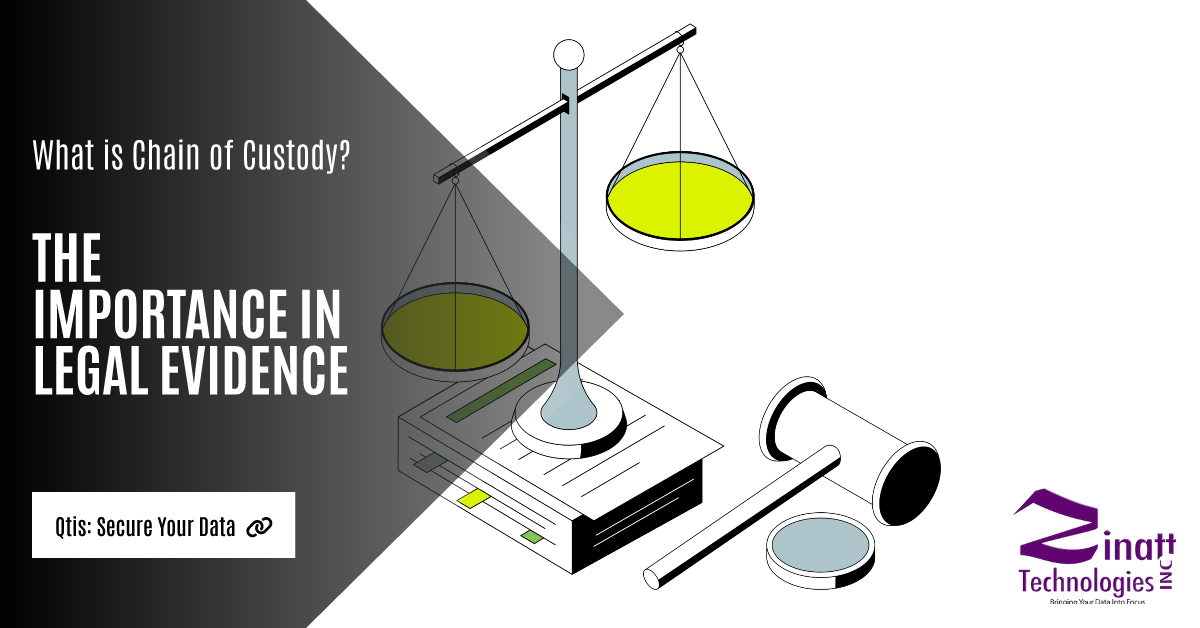Chain of custody forms the backbone of evidence management in legal proceedings. It creates accountability, prevents tampering, and helps ensure evidence admissibility in court. Without proper documentation, even the most compelling evidence may be rendered useless in legal proceedings.
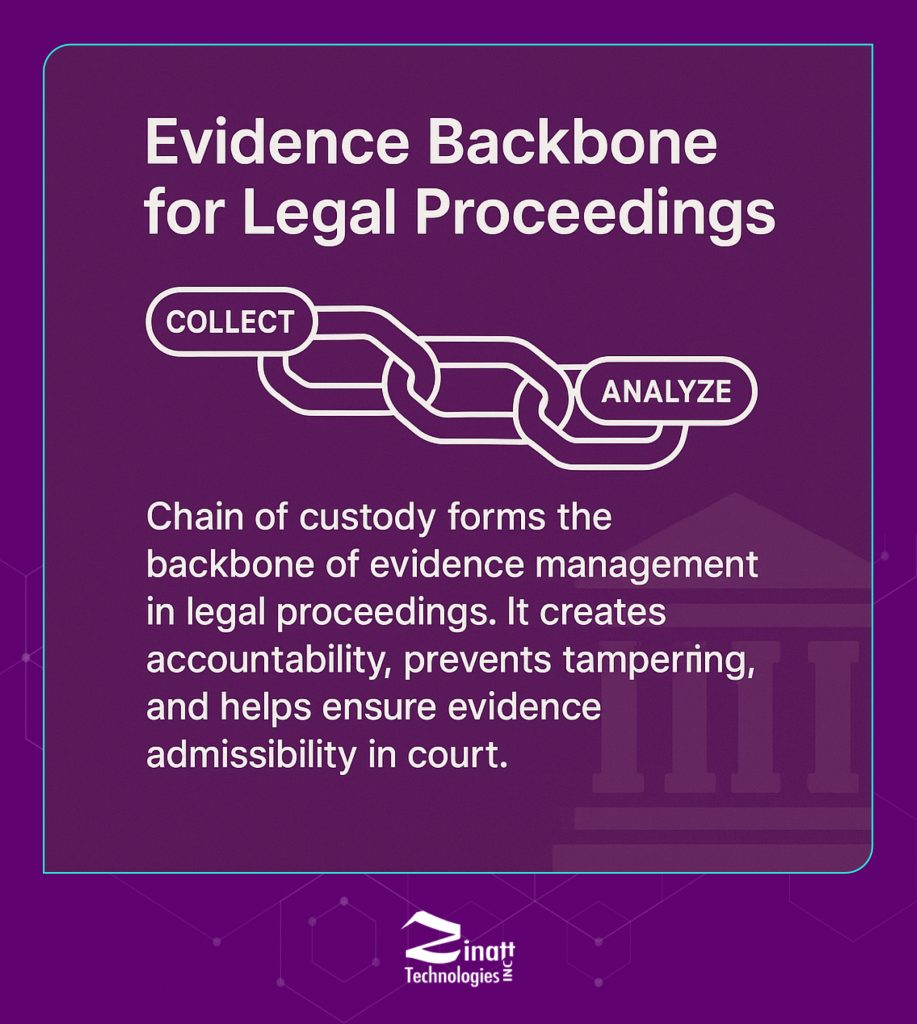
For organizations handling sensitive information or evidence, understanding chain of custody principles isn’t just good practice—it’s essential for maintaining data integrity and meeting legal requirements. This guide covers everything you need to know about chain of custody for both physical and digital evidence.
Defining Chain of Custody
Chain of custody refers to the chronological documentation that tracks evidence handling from collection through analysis, storage, transfer, and final disposition. Its primary purpose is to establish a verifiable trail proving evidence integrity and preventing tampering or contamination. (Source: Evidence Management)
Think of chain of custody as a detailed timeline. It shows exactly who handled evidence, when they accessed it, and what they did with it. This documentation creates accountability at every step.
Chain of custody matters in many contexts. Law enforcement agencies use it during criminal investigations. Hospitals maintain it for medical samples. Private investigators implement it for client evidence. Each industry adapts the basic principles to their specific needs.
| Element | Description | Purpose |
|---|---|---|
| Chronological Timeline | Sequential record of all evidence transfers | Establishes complete history |
| Handler Identification | Names and roles of all individuals accessing evidence | Creates accountability |
| Date and Time Stamps | Precise timing of all transfers and access | Prevents timeline gaps |
| Action Documentation | Record of all activities performed with evidence | Explains any changes |
| Security Measures | Documentation of storage conditions and protections | Proves evidence integrity |
The table above outlines the essential elements that make up proper chain of custody documentation. Each component works together to create a comprehensive record that can withstand legal scrutiny.
Key Components of Chain of Custody Documentation
Effective chain of custody documentation must include several critical elements. First, it requires identification of the evidence itself through clear labeling and description. Every document should include unique identifiers that distinguish each piece of evidence.
The documentation must record every person who handles the evidence. This includes their name, title, organization, and contact information. These details create clear accountability at each step in the process.
Timing elements prove particularly important in documentation. Records must include precise dates and times for each transfer or action. This chronological tracking prevents allegations of undocumented access or tampering.
Finally, the documentation must detail the reason for each transfer or handling event. Whether for analysis, storage, or court presentation, the purpose explains why someone accessed the evidence.
- Evidence identification – Descriptions, photos, and unique identifiers
- Handler information – Names, titles, organizations, and signatures
- Date and time records – Precise timestamps for all transfers
- Transfer reasons – Purpose for each handling event
- Storage conditions – Details on how evidence was secured
Who is Responsible for Maintaining Chain of Custody
Responsibility for maintaining chain of custody falls on everyone who handles evidence. Each person becomes a link in the chain. One weak link can compromise the entire process.
Organizations typically designate evidence custodians who oversee the management process. These individuals receive specialized training on proper documentation procedures. They often serve as the central point of contact for evidence-related questions.
In digital contexts, system administrators may share responsibility for electronic evidence. They implement access controls, audit logs, and backup systems that support chain of custody requirements.
Management holds ultimate responsibility for creating proper policies and procedures. They must ensure staff receives adequate training and follows established protocols consistently.

Why Chain of Custody Matters in Legal Proceedings
Chain of custody directly impacts whether evidence gets admitted in court. Minor documentation gaps may not invalidate evidence, but significant mishandling leads to exclusion. Courts apply these standards to ensure evidence reliability. (Source: EBSCO)
Defense attorneys carefully scrutinize chain of custody documentation. They look for weaknesses that could suggest tampering or contamination. Even small documentation errors can raise reasonable doubt about evidence integrity.
Many high-profile cases have hinged on chain of custody issues. When documentation fails, otherwise compelling evidence may become inadmissible. This can dramatically alter case outcomes.
| Chain of Custody Issue | Potential Legal Consequence | Case Impact |
|---|---|---|
| Missing Signatures | Questions about undocumented access | Moderate to Severe |
| Timeline Gaps | Allegations of tampering opportunity | Severe |
| Improper Storage | Claims of contamination or degradation | Severe |
| Documentation Errors | Challenges to overall process reliability | Moderate |
| Unauthorized Access | Evidence exclusion | Critical |
This table illustrates common chain of custody problems and their potential impact on legal proceedings. The consequences range from raising doubts to complete evidence exclusion.
Evidence Admissibility Requirements
Courts establish specific requirements for evidence admissibility. These standards ensure that only reliable evidence influences case outcomes. Chain of custody documentation helps meet these requirements.
Judges evaluate whether evidence has been properly authenticated. This means proving the evidence is what its proponent claims. Chain of custody documentation provides this authentication by tracking the evidence from collection to presentation.
The legal system values evidence integrity above all else. Proper chain of custody demonstrates that evidence remains unchanged from its original state. This integrity proves crucial for both physical and digital evidence.
Different jurisdictions may apply varying standards for chain of custody. However, the fundamental principle remains constant: evidence must be reliable to be admissible.
Consequences of a Broken Chain of Custody
Failure to maintain chain of custody allows defense attorneys to challenge evidence authenticity. They may suggest tampering or evidence planting when documentation gaps exist. These challenges can be devastating to a case. (Source: NCBI)
A broken chain of custody results in evidence being deemed inadmissible in court. For example, inconsistent records or inability to prove evidence handlers at specific times invalidates the chain. When this happens, even compelling evidence may be excluded from consideration.
The impact extends beyond individual cases. Improper evidence handling contributes to wrongful convictions in approximately 29% of DNA exoneration cases, according to an Innocence Project study. (Source: Evidence Management)
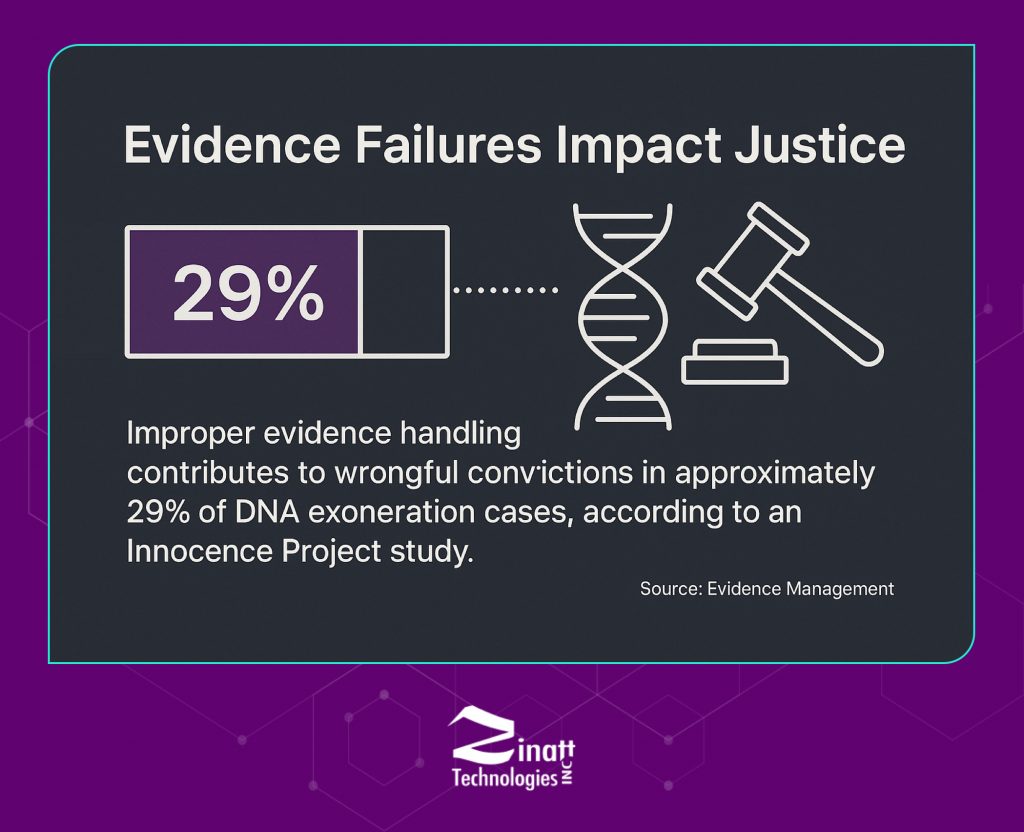
Organizations face reputation damage when chain of custody failures occur. These failures suggest procedural problems that may extend beyond individual cases.
Chain of Custody for Digital Evidence
Digital evidence presents unique chain of custody challenges. Electronic data can be copied, transferred, and modified without visible signs of tampering. This makes documentation even more critical than with physical evidence.
Digital chain of custody requires cryptographic hashing to detect alterations and audit trails for access tracking. Software-based systems are preferred over manual logs to reduce errors. These technical measures create verifiable proof of data integrity. (Source: Evidence Management)
Organizations must implement specialized procedures for digital evidence. These include write-blocking during acquisition, hash verification during transfers, and secure storage with access controls.
| Digital Evidence Type | Chain of Custody Challenges | Recommended Solutions |
|---|---|---|
| Email Communications | Metadata preservation, complete thread capture | Forensic collection tools, hash verification |
| Computer Hard Drives | Maintaining original state, preventing writes | Write-blockers, forensic imaging, hash verification |
| Mobile Devices | Remote wipes, encryption, battery issues | Faraday isolation, specialized extraction tools |
| Cloud-Based Data | Jurisdiction issues, changing data states | Legal preservation requests, API-based collection |
| Social Media Content | Authentication, complete context capture | Specialized collection tools, metadata preservation |
The table above outlines specific challenges and solutions for maintaining chain of custody across different types of digital evidence. Each type requires tailored approaches to ensure integrity.
Special Considerations for Electronic Data
Electronic evidence differs fundamentally from physical evidence. Digital data exists as bits and bytes rather than tangible objects. This creates both challenges and opportunities for chain of custody.
One key difference is the ability to create perfect copies of digital evidence. While this allows for backup preservation, it also means multiple identical versions may exist. Each copy requires its own chain of custody documentation.
Digital evidence often contains valuable metadata. This “data about data” includes creation dates, modification times, and user information. Preserving this metadata becomes an essential part of the chain of custody process.
Time synchronization presents another challenge. Different computer systems may have different clock settings. Chain of custody documentation must account for these potential time discrepancies.
Cryptographic Hashing and Verification Methods
Cryptographic hashing serves as the foundation of digital evidence verification. These mathematical algorithms generate unique “fingerprints” based on file contents. Even tiny changes to a file produce completely different hash values.
Common hashing algorithms include SHA-256, MD5, and SHA-1. Most digital forensic tools automatically calculate and verify these values during evidence handling. They provide mathematical proof that files remain unchanged.
Verification occurs by comparing hash values calculated at different points in time. If the values match, the file remains identical. If they differ, something has changed—possibly indicating tampering or corruption.
Beyond hashing, digital signatures add another layer of verification. These cryptographic tools not only verify content but also authenticate the creator or handler of the evidence.
Common Chain of Custody Challenges
Maintaining chain of custody presents several common challenges. Human error ranks among the most frequent problems. People may forget to document transfers, record incorrect information, or fail to follow procedures.
Resource limitations also create difficulties. Organizations often lack dedicated evidence management systems. Staff may have insufficient training on proper procedures. Time constraints can lead to documentation shortcuts.
In multi-agency situations, chain of custody becomes particularly complex. Different organizations may use different documentation systems. Evidence may transfer between agencies with different standards and procedures.
| Challenge Category | Specific Issues | Risk Level | Mitigation Strategies |
|---|---|---|---|
| Personnel Factors | Training gaps, high turnover, procedural inconsistency | High | Regular training, clear procedures, supervision |
| Process Weaknesses | Undefined procedures, missing verification steps | High | Documented workflows, process audits |
| Technical Limitations | Inadequate tools, system failures | Medium | Proper software, backup systems |
| Resource Constraints | Time pressure, staffing shortages | Medium | Process automation, prioritization |
| Multi-Agency Coordination | Inconsistent standards, communication gaps | High | Unified systems, clear handoff protocols |
This table categorizes common chain of custody challenges, their risk levels, and potential solutions. Organizations should assess their own processes against these common problem areas.
Documentation Gaps and Human Error
Documentation gaps often occur during high-pressure situations. When time is limited, proper record-keeping may suffer. Emergency situations particularly test chain of custody procedures.
Handwriting legibility creates persistent problems with paper-based systems. Illegible signatures or notes can render documentation useless. Electronic systems help address this issue by eliminating handwriting concerns.
Shift changes present another vulnerable point. Evidence transfers between personnel on different shifts may lack proper documentation. Formal handoff procedures can help prevent these gaps.
Simple forgetfulness accounts for many documentation errors. Staff may collect evidence but delay completing paperwork. This creates reconstruction challenges later.
Storage and Transfer Vulnerabilities
Evidence storage facilities require strict access controls. Each entry and exit should be documented. Unauthorized access can break the chain of custody and compromise evidence integrity.
Physical transfer of evidence creates inherent vulnerabilities. Evidence in transit faces risks of loss, damage, or tampering. Proper packaging, sealing, and transport documentation helps mitigate these risks.
Long-term storage presents its own challenges. Evidence may degrade over time due to environmental factors. Proper storage conditions and periodic verification become essential for maintaining integrity.
Chain of custody documentation must account for these vulnerabilities. It should demonstrate that proper protections remained in place throughout the evidence lifecycle.
Best Practices for Maintaining Chain of Custody
Effective chain of custody requires comprehensive documentation. Organizations should implement standardized forms and procedures that capture all essential information. Consistency helps prevent documentation gaps.
The chain of custody process tracks and documents evidence’s journey through collection, analysis, storage, and disposition phases. Each step requires careful attention to maintain evidence integrity. (Source: UCS Logistics)
Digital solutions offer significant advantages over paper-based systems. They provide automated tracking, access controls, and audit logs. These features reduce human error and improve documentation consistency.
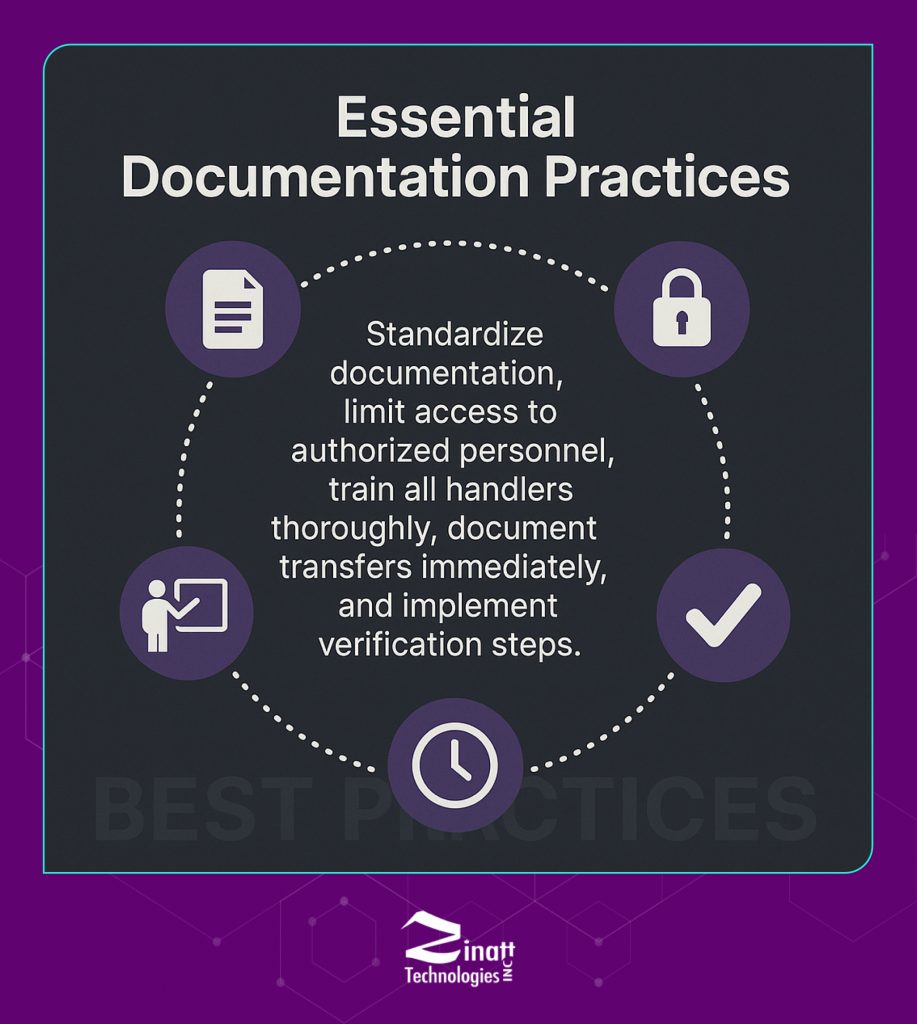
- Standardize documentation – Use consistent forms and procedures
- Limit access to authorized personnel – Implement strict access controls
- Train all handlers thoroughly – Ensure everyone understands procedures
- Document transfers immediately – Never delay completing transfer records
- Implement verification steps – Use checks and balances throughout the process
Implementing Proper Documentation Protocols
Organizations should establish clear documentation protocols. These should specify exactly what information must be recorded for each evidence transfer or handling event.
Documentation protocols should address both routine and exceptional situations. Special procedures may apply for high-value evidence, sensitive materials, or emergency circumstances.
Regular audits help ensure compliance with documentation protocols. These reviews identify gaps or weaknesses in the process. They also provide opportunities for continuous improvement.
Training remains essential for protocol implementation. All personnel who may handle evidence should receive comprehensive instruction on documentation requirements. Refresher training helps maintain standards over time.
Technology Solutions for Chain of Custody Management
Modern chain of custody management relies increasingly on specialized software. These systems automate documentation, implement access controls, and maintain comprehensive audit trails.
Barcode and RFID technologies streamline evidence tracking. They allow for quick, accurate scanning during transfers. These technologies reduce manual data entry errors and speed up the documentation process.
Digital signature capabilities add security to electronic documentation. They verify the identity of each person in the chain. This verification helps prevent unauthorized access or fraudulent documentation.
Analytics features in modern systems provide valuable insights. They help identify process bottlenecks, compliance issues, and training needs. This data-driven approach supports continuous improvement.
Chain of Custody in Different Industries
Chain of custody principles apply across multiple industries. Law enforcement represents the most obvious application. Police departments maintain detailed evidence records for criminal prosecutions.
Healthcare organizations implement chain of custody for medical samples. Laboratories track specimens from collection through testing and disposal. Proper documentation prevents mix-ups and ensures reliable results.
Private sector investigations also require chain of custody. Corporate security teams document evidence for internal investigations, civil litigation, or potential criminal referrals.
| Industry | Evidence Types | Special Considerations | Documentation Focus |
|---|---|---|---|
| Law Enforcement | Physical evidence, digital devices, biological samples | Court admissibility, long-term storage | Complete chronology, handler details |
| Healthcare | Biological specimens, medication, medical devices | Patient privacy, contamination prevention | Collection methods, temperature control |
| Corporate Security | Documents, surveillance footage, computer data | Employee privacy, business continuity | Authorization, limited access |
| Environmental Testing | Water samples, soil specimens, air quality samples | Environmental conditions, preservation methods | Collection location, sampling methods |
| Product Manufacturing | Component samples, quality test results | Batch tracking, regulatory compliance | Production dates, test parameters |
The table above illustrates how chain of custody principles adapt to different industry contexts. While the core concepts remain consistent, implementation details vary based on specific industry needs.
Law Enforcement and Criminal Investigations
Law enforcement agencies face particularly strict chain of custody requirements. Criminal evidence must withstand intense scrutiny in court. Documentation must be meticulous and complete.
From crime scene to courtroom, officers document every evidence transfer. This includes collection, packaging, transport to storage, laboratory submission, and eventual court presentation. Each step requires proper documentation.
Digital evidence presents growing challenges for law enforcement. Computer forensics requires specialized tools and procedures. Officers must maintain chain of custody while extracting data from devices or online sources.
Many agencies now implement digital evidence management systems. These specialized platforms automate much of the documentation process. They help ensure consistent compliance with chain of custody requirements.
Private Sector Applications
Private organizations adapt chain of custody principles to their specific needs. Corporate security teams use these procedures during internal investigations. This documentation proves particularly important when investigations might lead to termination or legal action.
Intellectual property protection often involves chain of custody. Companies document the development and handling of trade secrets, patents, and other valuable intellectual assets. This documentation helps establish ownership and protect against theft.
Information security incidents also trigger chain of custody procedures. When investigating data breaches or system compromises, security teams document their actions. This documentation may later support legal proceedings against attackers.
Private investigators implement chain of custody for client matters. They must maintain credible documentation for any evidence that might be used in civil litigation or provided to law enforcement.
The Future of Chain of Custody Management
Chain of custody management continues to evolve. New technologies offer improved automation, verification, and security. These advances help organizations maintain more reliable documentation with less manual effort.
Blockchain technology shows particular promise for chain of custody applications. Its immutable ledger creates tamper-evident documentation. Once recorded, entries cannot be altered without detection.
Artificial intelligence may soon play a role in chain of custody management. AI systems can detect anomalies, flag potential documentation errors, and ensure compliance with procedures.
- Blockchain-based verification – Immutable records of all transfers
- Biometric authentication – Advanced identity verification for handlers
- AI-powered compliance monitoring – Automated detection of procedure violations
- Mobile documentation tools – Field-based evidence processing
Emerging Technologies and Approaches
Mobile technologies increasingly support field-based documentation. Officers and investigators can record chain of custody information at the point of collection. This immediate documentation reduces errors and improves accuracy.
Cloud-based evidence management systems offer new capabilities. They provide secure access from multiple locations. These systems support collaboration while maintaining strict access controls.
Integration between systems streamlines the documentation process. Evidence management platforms can connect with laboratory information systems, court management software, and other related tools. This integration reduces duplicate data entry and improves consistency.
Automated notifications alert supervisors to potential problems. When documentation appears incomplete or procedures aren’t followed, these systems flag the issues for immediate attention.
Training and Compliance Considerations
As technology evolves, training becomes increasingly important. Staff must understand both the principles behind chain of custody and the specific tools used for documentation.
Compliance programs should include regular audits and reviews. These activities verify that procedures are being followed consistently. They also identify opportunities for process improvement.
Certification programs offer standardized training for evidence handlers. These programs ensure consistent knowledge across organizations. They also provide formal recognition of competency.
Regular policy updates keep procedures current with changing technologies and legal requirements. Organizations should review and revise their chain of custody policies at least annually.

Ensuring Evidence Integrity Through Proper Chain of Custody
Chain of custody forms the foundation of evidence integrity. Proper documentation creates accountability, prevents tampering allegations, and ensures admissibility in legal proceedings.
Organizations across industries benefit from implementing strong chain of custody procedures. These practices protect evidence validity, support investigations, and maintain legal compliance.
Modern technology offers powerful tools for chain of custody management. From specialized software to emerging blockchain applications, these solutions help organizations maintain more reliable documentation with less effort.
The critical role of evidence chain of custody in justice cannot be overstated. When properly implemented, it helps ensure that investigations reach accurate conclusions based on reliable evidence. (Source: Evidence Management)
Organizations seeking to improve their evidence management should evaluate their current procedures against best practices. Implementing standardized documentation, providing comprehensive training, and leveraging appropriate technology can significantly enhance chain of custody reliability.



 520 838 0346
520 838 0346 sales@zinatt.com
sales@zinatt.com